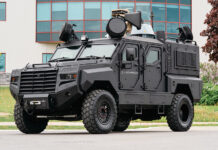In recent years the Latin American market has been aligned along two parallel axis – one led by the U.S., including Colombia, Costa Rica, Mexico, Paraguay, Peru, Salvador and, more recently Chile. The other, led by Venezuela and its charismatic leader Hugo Chaves, followed by Ecuador, Bolivia and Nicaragua. Prosperous Brazil has remained nonaligned, with economically pressed Argentina leaning toward Venezuela, handing generous support to its fledged economy.
Latin American defense spending is expected to grow from approximately $63 billion in 2011 to more than $65 billion by 2014, according to Forecast International’s “The Military Market for Latin America” report. Forecast estimates that about 20 percent of this amount will be available for military procurements, with the rest tied up in salaries and sometimes social security or pension funding. The market leaders are Brazil, Colombia, Venezuela, Chile and Mexico account for 90% of total defense spending in the region.
Internal conflict remains the primary driver behind the Latin American arms market. While the region as a whole faces minimal external threat; armed guerilla groups pose the real peril to regional stability. However, many of these homegrown guerilla groups are no longer contained within the confines of their own nation and continue to increase in militancy. Assisting local governments combating drug traffickers, the U.S. government is offering significant financial, intelligence as well as operational support, eradicating coca fields, processing and trafficking.

“As violence spills over the borders, the governments of Latin America must push for enhanced military capabilities to fight back,” said Forecast’s Latin America & Caribbean analyst Rebecca Barrett. “It is this internal conflict that is driving the long-overdue force modernization for the region.”
With the region finally emerging from a downward economic cycle, Latin-American defense market has shown stability through the most recent global recession. Thus prospects for the defense market are showing improvement” Barrett said.
“Seeking to boost its position as a global superpower, Brazil’s need to modernize its armed forces is pressing.” Barrett added, “Between protecting its vast offshore oil fields and resource-rich Amazon from terrorist groups, Brazil must rely on its military to protect its national sovereignty and secure its wealth.”
Through the years Brazil has maintained an independent foreign policy, economy, and culture, a strategy that also determined its national defense and internal security posture. While the U.S. and European economies are stagnating, Brazil’s economy has increased dramatically in recent years, along with the world’s fastest growing economies – Russia, China and India (BRIC).
Unlike Brazil, relying on internal funding for defense procurement, Venezuela’s ambitious arms procurement plans are being financed by generous Russian funding. With the U.S. Embargo restricting western trade with the country, Russia has undeniably dominated the Venezuelan market in recent years with sales reaching as high as $6.6 billion. providing that all current contracts are carried out. “Russia is pushing hard for domination of the Latin American arms market and has been successful because of the flexible financing options and wide array of equipment offered at reasonable prices,” said Barrett. “In addition to Venezuela, Argentina and Peru are also emerging as lead buyers of Russian hardware.”
















